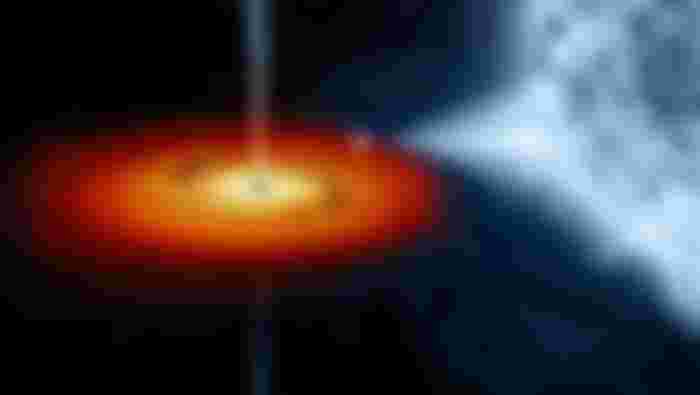Black Hole is a term widely famous in science fiction movies and physics debates, but all of that is about to change. After a hundred years since Einstein's Theory of Relativity was published, scientists have finally found visible proof of the existence of black holes. The first image of one was released on April, 2019 by the Event Horizon Telescope Collaboration (EHT).

Firstly, let's clear some things up , the image is blurry because it's a zoomed in version of a much larger image, so basically, the image is just too small as the black hole is extremely far away and hence the blurriness. Next, what are we exactly looking at ? Well the image shows the central black hole of the distant Messier - 87 (or M-87 in short) galaxy and it's 55million light years away ( that's 5.20329062 × 10^20 kilometres) from Earth. Since light takes 55million years from the Black hole to reach us , what we're looking at is actually how the Black hole 'looked like' 55million years ago, not how it looks like right now at this moment. It's like a look into the past and it's magical. This black hole at M-87 has a mass of 6.5billion times of our Sun and the black hole itself is actually invisible in the image, we only see the shadow of it in the central dark part. The orange light around it is actually glowing hot plasma that surrounds and rotates around the black hole, making up its accretion disk. For anyone who asks , accretion disk around any celestial object ( stars, planets, moons) is basically a ring of matter , all lying in flat plane in a circular disk shape. For example, Saturn has an accretion disk around it and our Sun had an accretion disk in the past too, which eventually became planets and hence most planets lie on the same plane. This black hole too has an accretion disk of hot plasma rotating around it at near light speeds. And due to the lensing effect, which is a fancy term for saying " gravity bends light", the parts going away from us. The black hole itself is supermassive , with a very high gravitational pull. But it does have jets of plasma coming out of it from the top and the bottom , theorized to be caused by immensely strong magnetic fields. Of the two jets, the lower one is invisible as it's shooting away from us, and the other one is almost directly pointed at us, suggesting we are looking at the black hole almost perpendicularly, from the top.
Now just to clarify things, that image isn't actually how we'll see that black hole if we were there, in fact, the colors are representations of the original radio image, because as light from the gas around the black hole was too bright for our telescopes to see through, the only way to view the black hole inside all of this mess was to build a earth-sized radio telescope. That being impractical, the scientists at the EHT used 8 telescopes all around the world along with earth's own rotation to simulate an earth- sized radio telescope ( the technique is called very- long - baseline inferometry or VLBI) , then an algorithm was developed to find picture by MIT grad student Katie Bouman . And it worked ! Years of research, time and extreme hard work finally paid off ! The things the team of 200 scientists did for a goal seemingly impossible ended up with a discovery that's going to humanity's hall of fame.
The magic in moments like this is how we as a species push ourselves to test things proven only theories and turn them into reality. This image is a fine example of that, it really pushed us to the limits of what we can see with our current technology, had it been a few million more light years away, we could never have found a good image of this black hole. This is not the end of black hole discoveries though, the EHT team has one more image to be released, and it's the image of the Saggitarius-A star, the central black hole in our Milky Way galaxy. And with things like LIGO (Laser Inferometry Gravitational wave Observatory) coming online the future of space observation is very bright.

Great article dear 🤗